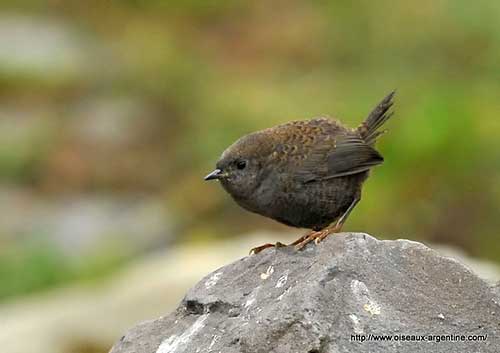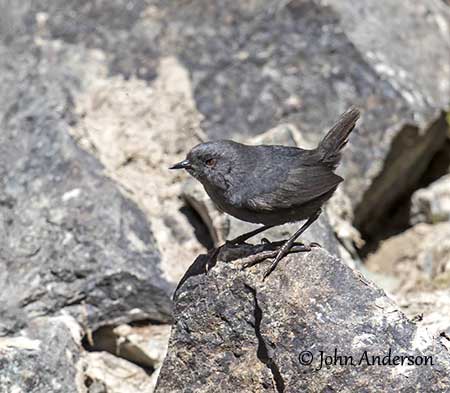
PROTECTION/THREATS/ STATUS:
The Magellanic Tapaculo has large range in which it is described as common to fairly common.
The species is affected by habitat fragmentation, involving isolated small populations. However, large parts of the range are protected in Chile and Argentina.
More information is needed, but the species is not considered globally threatened, and the Magellanic Tapaculo is currently evaluated as Least Concern.
Fr: Mérulaxe des Andes
Ang: Magellanic Tapaculo - Andean Tapaculo
All: Magellantapaculo
Esp: Churrín Magallánico
Ita: Tapaculo di Magellano
Nd: Magelhaentapaculo
Sd: magellantapakul
Photographers:
John Anderson
John Anderson Photo Galleries
Philippe et Aline Wolfer
GALERIE
Text by Nicole Bouglouan
Sources:
HANDBOOK OF THE BIRDS OF THE WORLD Vol 8 By Josep del Hoyo-Andrew Elliott-David Christie - Lynx Edicions - ISBN: 8487334504
BIRDS OF SOUTH AMERICA – Passerines - by Robert S. Ridgely and Guy Tudor – HELM Field Guides – ISBN: 9781408113424
The Birds of South America: Vol. II, The Suboscine Passerines De Robert S. Ridgely, Guy Tudor, William L. Brown, World Wildlife Fund - University of Texas Press, 1989 - ISBN: 0292770634, 9780292770638 - 940 pages
Fatbirder - The World’s Richest Information Resource about Birds for Birders
Nesting Biology of Tapaculos (Rhinocryptidae) in Fragmented South-Temperate Rainforests of Chile
Habitat selection of endemic birds in temperate forests in a biodiversity “Hotspot”
First records of Rhynocryptid understory birds in the canopy of Chilean temperate rainforests
Wikipedia, the free encyclopaedia
Magellanic Tapaculo
Scytalopus magellanicus
Passeriformes Order – Rhynocryptidae Family
INTRODUCTION:
The Magellanic Tapaculo is the smallest member of genus Scytalopus. It is now a monotypic species. It is found from C Chile and W Argentina, S to Tierra del Fuego.
It frequents the temperate rainforests, and especially the adjacent bamboo thickets within the forest or at the edge. It is resident.
Due to its small size and the dark grey plumage, the Magellanic Tapaculo is difficult to find, but it is often located by its repetitive song, given all year round. It feeds on a variety of arthropods, and especially tiny insects, but the foraging behaviour is poorly known.
This species builds a globular nest placed in hole or crack between the trunk and the bark, or among the roots of fallen trees.
The Magellanic Tapaculo has large range in which it is described as common to fairly common. It is not currently globally threatened.
DESCRIPTION OF THE BIRD:
Biometrics:
Length: 9,5 cm
Weight: 10,5-14 g
The Magellanic Tapaculo adult male has dark grey plumage with slightly paler underparts. We can see a limited amount of rufous on lower flanks and thighs, often with dark bars.
On the upperwing, the inner flight-feathers are dark brown with black subterminal bar and narrow, brown tip. The cocked tail is grey.

On the head, the forecrown is often silvery-white with scaly effect, but this feature may differ between individuals.
The pointed bill is blackish with greyish base. The eyes are dark brown. Legs and feet are flesh-coloured.
The female is similar but she has paler appearance.
The juvenile is brown with darker bars. It lacks the white crown feathers.
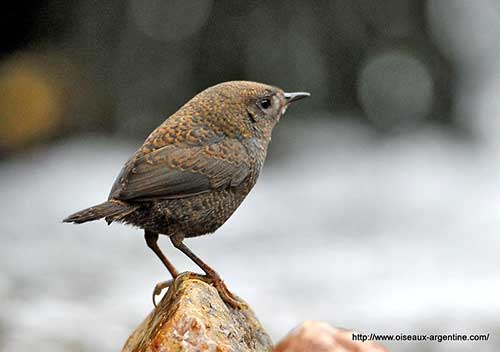
RANGE:
The Magellanic Tapaculo occurs in C and S Chile and W Argentina, S to Cape Horn.
A specimen was collected in the Falkland Islands in the 19th century by Charles Darwin, but habitat degradation on these islands has precluded further sightings of the species.
HABITAT:
The Magellanic Tapaculo frequents the dense vegetation in forest and woodland, and forages on the ground in the thick undergrowth. It is also found in bamboo thickets near the edge of the forest, and especially in patches of Chusquea bamboo. It also frequents rocky grasslands.
From an observation (from January to April 2017), the species was observed in the canopy of Chilean temperate rainforest for the first time.
The Magellanic Tapaculo occurs between 1,000 and 2,300 metres of elevation in Chile, but up to 3,500 metres in Mendoza in Argentina, and from sea-level to 1,000 metres in the south.
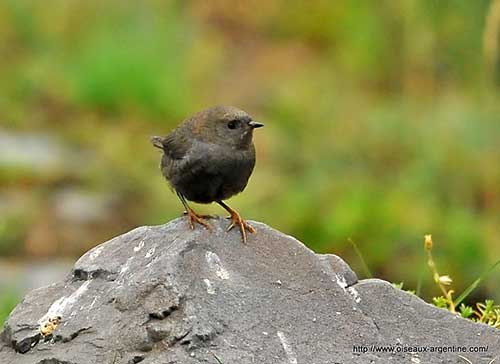
CALLS AND SONGS: SOUNDS BY XENO-CANTO
The members of genus Scytalopus are very similar in appearance to each other, and the voice plays an important role to identify them.
The contact call of the Magellanic Tapaculo is a slightly rising trill of 12-15 notes uttered in 1,5-2 seconds.
The alarm call given by both adults, is a slightly falling trill including first 5-7 notes, followed by a short series of 3 notes, and a second series of other 3 notes with the first longer and the last shorter.
The song is a repeated, rhythmic “ka-chéw, ka-chéw, ka-chéw, ka-chéw…” that may last several minutes without a pause. The phrases are given at a rate of about 2 per second.
BEHAVIOUR IN THE WILD:
The members of genus Scytalopus feed mainly on tiny insects. They glean their prey from moss, leaf litter, earth and rotting vegetation, while moving quickly on the ground or in the undergrowth.
They are “mouse-like” while foraging under roots, on mossy rocks or among tussocks of grass.
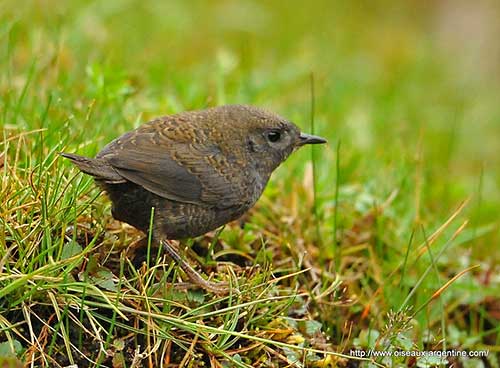
The tapaculos are often found in pairs, and both mates keep in vocal contact with one another. They are strongly territorial.
They are generally restless and fast-moving birds. When disturbed, they prefer to run rather than fly.
The Magellanic Tapaculo is sedentary.
Tapaculos have short wings and are poor fliers. They easily become isolated in small populations within their highly localised distribution.
REPRODUCTION OF THIS SPECIES:
The laying takes place in October/November.
The Magellanic Tapaculo builds the nest in cracks in trees between the trunk and the bark, but also among the roots of fallen trees or on banks covered with ferns.
The domed, globular nest is made of mosses, lichens and vegetal fibres. It is lined with soft grass and horse hair. It is probably built by both adults.
The female usually lays 2-3 white, unmarked eggs, but this species has been reported occasionally to lay 4 eggs in a clutch.
Both adults probably share the incubation roughly estimated at more or less 15 days. Both parents feed the chicks with insects. The nestling period is unknown.
